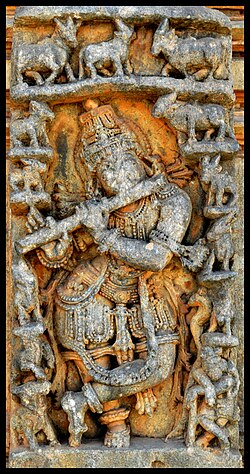 Krishna playing flute with his herd of cows in Bucesvara Temple, Koravangala. 12th century. Krishna playing flute with his herd of cows in Bucesvara Temple, Koravangala. 12th century. | |
| Woodwind instrument | |
|---|---|
| Classification | woodwind |
| Hornbostel–Sachs classification | 421 (421.11 End-blown flutes 421.12 Side-blown flutes) |
| Developed | Unknown where flutes developed. Flutes tens-of-thousands of years old have been discovered in Europe and Asia. Bamboo flutes spread from China and India, along silk road, and across the oceans to Southeast Asia and Africa. Native Americans also made bamboo flutes. |
The bamboo flute, especially the bone flute, is one of the oldest musical instruments known. Examples of Paleolithic bone flutes have survived for more than 40,000 years, to be discovered by archaeologists. While the oldest flutes currently known were found in Europe, Asia too has a long history with the instrument that has continued into the present day. In China, a playable bone flute was discovered, about 9000 years old.
Historians have found the bamboo flute has a long history as well, especially China and India. Flutes made history in records and artworks starting in the Zhou dynasty. The oldest written sources reveal the Chinese were using the kuan (a reed instrument) and hsio (or xiao, an end-blown flute, often of bamboo) in the 12th-11th centuries b.c., followed by the chi (or ch'ih) in the 9th century b.c. and the yüeh in the 8th century b.c. Of these, the chi is the oldest documented cross flute or transverse flute, and was made from bamboo. The Chinese have a word, zhudi, which literally means "bamboo flute."
The cross flute (Sanscrit: vāṃśī) was "the outstanding wind instrument of ancient India," according to Curt Sachs. He said that religious artwork depicting "celestial music" instruments was linked to music with an "aristocratic character." The Indian bamboo cross flute, Bansuri, was sacred to Krishna, and he is depicted in Hindu art with the instrument. In India, the cross flute appeared in reliefs from the 1st century a.d. at Sanchi and Amaravati from the 2nd-4th centuries a.d.
In the modern age, bamboo flutes are common in places with ready access to bamboo, including Asia, South and Southeast Asia, South America, and Africa.
See: Chinese flutes
End blown flute mouthpieces
| Name | Description | Picture |
|---|---|---|
| Xiao blowing hole | (the hole faces away from the player, against the lower lip, making sure the top lip is not concealing the hole, when the instrument is played. Works on the same basics as blowing air over an empty bottle to create noise.) | 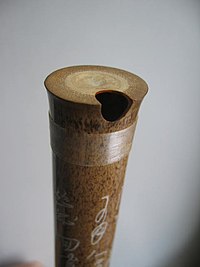 |
| Shakuhachi | Kinko school utaguchi (歌口, blowing edge) and inlay. The shakuhachi player blows as one would blow across the top of an empty bottle (though the shakuhachi has a sharp edge to blow against called utaguchi) and therefore has substantial pitch control. | 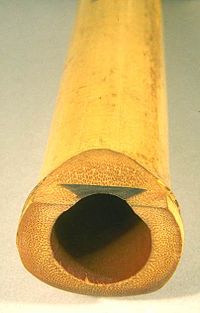 |
| Hotchiku | Same technique as shakuhachi. The angle of the utaguchi (歌口, lit. "singing mouth"), or blowing edge, of a hotchiku is closer to perpendicular to the bore axis than that of a modern shakuhachi. | 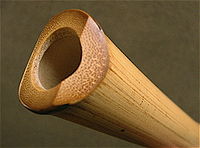 |
| Quena | To produce sound, the player closes the top end of the pipe with the flesh between the chin and lower lip, and blows a stream of air downward, along the axis of the pipe, over an elliptical notch cut into the end. |  |
| Khlui | Thailand. A block has been put into the end of the flute, an internal fipple that creates a hole to blow through, channeling air through a duct to create sound. |  |
List of bamboo flutes, cane flutes, reed flutes
This list is intended to show flutes made of bamboo. It excludes pan flutes or panpipes, and flutes and whistles that don't have finger positions to change notes. It also excludes pipes that use reeds to produce the sound. Bamboo is a grass, and some "cane" or "reed" flutes may get listed here, as long as the plant is being used for a tube that is blown into or across to create noise. Types of flutes include transverse flutes (also called cross flutes), end-blown flutes (ring flutes are included with these) and Nose flutes. Fipple flutes, also called duct flutes, may be added to the list as well, as long as they are bamboo-based instruments. The bamboo variant may be added for instruments that include wood and bamboo versions.
| Name in English | Name in other language | Place / Region | Picture | Soundhole | Description |
|---|---|---|---|---|---|
| Atenteben | Ghana | ||||
| Bansuri | Bangladesh |  |
|||
| Bansuri | India |  |
|||
| Bām̐surī | (Nepali: बाँसुरी) | Nepal |  |
||
| Bata Nalawa | Sri Lanka | ||||
| Chi | China | ||||
| Dizi | Chinese: 笛子 pinyin: dízi) |
China |  |
||
| Daegeum | Korean: 대금 | Korea |  |
||
| Dangjeok or Jeok | Korean: 당적; Hanja: 唐笛 | Korea |  |
Notched flute | |
| Danso | 단소; 短簫 | Korea |  |
||
| Donali | دونَلی | Iran | |||
| Dongdi | China | ||||
| Fijian nose flute | Viti Levu | 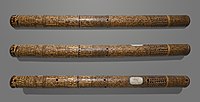 |
Nose flute | This nasal flute is made from a section of bamboo, pierced with nine holes. The entire surface is decorated with geometric patterns of different shapes, forming several registers in the vertical direction. To play the flute, a hole must be applied against one nostril while the other is blocked by the fingers. | |
| Friscolettu | Sicily | fipple | Seven holes on the front, two in the back | ||
| Hotchiku | 法竹 | Japan |  |
||
| Gasbah | الڨصبة (Egyptian Arabic), Taghanimt (Berber language) | Maghreb |  |
oblique (bevel is cut on the end of the tube) | Oblique flutes are played with the musician be holding the flute at an angle to the mouth, blowing across a bevel cut in the end. Similar to Ney. |
| Garau-nai | Uzbekistan, Tajikistan | ||||
| India nose-flute bansuri | West Bengal |  |
Fipple | In 1799, artist Frans Balthazar Solvyns depicted an end-blown flute, called Bansuri (like the side-blown flute), being played nasally. | |
| Ji | Korea | ||||
| Junggeum | 중금; 中笒 | Korea |  |
||
| Kagurabue | (Japanese: 神楽笛)) | Japan | |||
| Khloy | Khmer: ខ្លុយ Burmese: ပုလွ |
Cambodia Myanmar (Burma) |
 |
internal fipple |
end-blown duct flute. Mouthhole on bottom of pipe's end, soundhole on flute's bottom (opposite side of the pipe from the fingerholes). This flute may have as many as 8 fingerholes, plus up to 2 additional thumbholes; the thumbholes offer additional notes. |
| Khlui | (Thai: ขลุ่ย | Thailand |  |
internal fipple |
end-blown duct flute. Mouthhole on top of pipe's end, soundhole on flute's top. |
| Komabue | Japanese: 高麗笛 | Japan | |||
| Koudi | Chinese: 口笛 pinyin: kǒudí |
China |  |
||
| Lalove | Indonesia | ||||
| Malaysian nose flute | Sarawak |  |
Nose flute | ||
| Minteki or shinteki | minteki: (kanji: 明笛 shinteki: (kanji: 清笛)) |
Japan |  |
||
| Moseño | Andes mountains | ||||
| Murali | Nepal | ||||
| Native American flute | United States (Native American) | ||||
| Nohkan | 能管 | Japan |  |
||
| Ney | Iran | ||||
| Ohe Hano Ihu | Hawaii | ||||
| Paiwan nose flute | Taiwan |  |
Nose flute | Instrument of the Paiwan people of Taiwan. | |
| Palendag | Philippines |  |
|||
| Palwei (German Misplaced Pages) | Burmese: ပလွေ | Myanmar |  |
||
| Pinkillu | Peru, Andes mountains |  |
|||
| Quena | Andes |  |
|||
| Ryūteki | Japan |  |
|||
| Sáo | Sáo trúc | Vietnam |  |
||
| Shakuhachi | 尺八 | Japan | 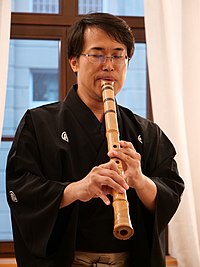 |
||
| Shinobue or takebue | Shinobue:
Takebue: |
Japan |  |
||
| Sogeum | 소금; 小笒 | Korea | |||
| Suling | Indonesia |  |
|||
| Suling | Papua, New Guinea |  |
|||
| Tahitian nose flute | Tahiti | 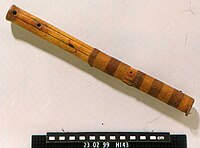 |
Nose flute | Bamboo nose flute bound with bands of colored coconut fiber. Collected from Tahiti, the Society Islands during Cook's voyages to the Pacific 1768–1780. | |
| Tongso | 퉁소 | Korea |  |
||
| Venu | Sanskrit: वेणु | India | |||
| Wa | Myanmar | ||||
| Xiao | Chinese: 簫 Simplified Chinese: 箫 Pinyan: xiāo |
China |  |
||
| Xindi | Chinese: 新 笛; pinyin: xīndí |
China | |||
| Yak | 약 | Korea |  |
||
| Yokobue | Japan | ||||
| Yue | China |
References
- ^ "Earliest music instruments found". BBC News. 25 May 2012. Archived from the original on 11 April 2022. Retrieved 30 November 2020.
- "Brookhaven Lab Expert Helps Date Flute Thought to be Oldest Playable Musical Instrument, Bone flute found in China at 9,000-year-old Neolithic site". Brookhaven National Laboratory. Archived from the original on 2002-02-25. Retrieved 2020-11-30.
- ^ Sachs, Kurt (1940). The History of Musical Instruments. New York: W. W. Norton & Company. pp. 178–179.
- "Ancient Chinese Musical Instrument's Depicted On Some Of The Early Monuments In The Museum". University of Pennsylvania Museum of Archaeology and Anthropology. Archived from the original on 2021-08-18. Retrieved 2020-11-30.
The Erh Ya (c. 400 B.C.) says the ch'ih was made of bamboo, its length was 16 inches, one hole opened upwards, and it was blown transversely.
- ^ Chen-Gia Tsai. "Chinese flutes and their music" (PDF). The Chinese Membrane Flute (dizi): Physics and Perception of its Tones (PhD thesis). Humboldt-University Berlin. Archived from the original (PDF) on 22 February 2014. Retrieved 15 February 2014 – via Graduate Institute of Musicology at National Taiwan University.
- This text appears to be: Chen Gia Tsai (28 November 2003). The Chinese Membrane Flute (dizi): Physics and Perception of its Tones (PhD thesis). Humbolt University Berlin. Archived from the original on 30 June 2023. Retrieved 30 November 2020 – via Scribd.
- ^ Sachs, Kurt (1940). The History of Musical Instruments. New York: W. W. Norton & Company. pp. 158–159, 180.
- Kadel, Ram Prasad (2007). Musical Instruments of Nepal. Katmandu, Nepal: Nepali Folk Instrument Museum. p. 45. ISBN 978-9994688302.
Banshi...\transverse flute...made from bamboo with six finger holes...known as Lord Krishna's instrument.
- Akrofi, Eric (2016-11-30). "Personalities in World Music Education No 14 – J.H. Kwabena Nketia". International Journal of Music Education: 41–45. doi:10.1177/025576149201900106. S2CID 143945839.
- "Atenteben - Ghanian whistle". The Kwela Project. 8 September 2013. Archived from the original on 2019-10-21. Retrieved 2019-10-21.
- Onovwerosuoke, Wendy Hymes (2008-01-01). "New horizons: the world of African art music for flute: African art music offers rich programming opportunities, but scores often are unpublished and can be challenging to find. Insights are offered about some of Africa's foremost composers--among them the author's husband". Flutist Quarterly: 16–26. Archived from the original on 2023-06-30. Retrieved 2019-11-20.
- Suneera Kasliwal (2004). Classical musical instruments. Rupa. pp. 85–86. ISBN 978-81-291-0425-0. Archived from the original on 2023-06-30. Retrieved 2020-11-30.
- Salcedo, Pablo. "Pablo Salcedo. World Flutes Master". www.pablosalcedo.org. Archived from the original on 2020-02-22. Retrieved 2015-09-29.
- "TANSO". Grinnell College. Archived from the original on 2016-01-01.
- Scola, Allison. "Friscalettu: Sicily's Reed Flute" Archived 2022-08-08 at the Wayback Machine, Experiencesicily.com website, July 29, 2016. Retrieved May 23, 2021.
- Deaver, Tom. "HOCHIKU vs. SHAKUHACHI". shikan.org. Archived from the original on 2019-09-07. Retrieved 2020-11-30.
- ^ Sadie Stanley, ed. (1984). "Gasba". The New Grove Dictionary of Musical Instruments. Vol. 2. London: MacMillan Press. p. 26.
an oblique rim-blown flute.
- "Nai". thefreedictionary.com. Archived from the original on 2021-04-13. Retrieved 2020-11-30.
The following article is from The Great Soviet Encyclopedia (1979)...An Uzbek and Tadzhik transverse flute...Depending on the material from which it is made the nai is called agach-nai (wooden), garau-nai (bamboo), misnai (tin), and brindgzhi-nai (brass)
- "문예진흥원 홈페이지". Archived from the original on September 28, 2007.
- David Petersen (March 2007). An Invitation to Kagura: Hidden Gem of the Traditional Japanese Performing Arts. David Petersen. pp. 275–. ISBN 978-1-84753-006-6. Retrieved 17 July 2011.
- Sam-Ang, Sam (2008). "The Khmer People of Cambodia". In Miller, Terry E.; Williams, Sean (eds.). The Garland Handbook of Southeast Asian Music. New York, US: Taylor & Francis. p. 97. ISBN 9781135901547. Archived from the original on 2023-06-30. Retrieved 2020-11-30.
- ^ "ប្រវត្តិ "ខ្លុយ" (translation:History of the Khloy". choukhmer.wordpress.com. 6 July 2010. Archived from the original on 5 December 2020. Retrieved 5 December 2020.
រន្ធ មាន បង្ហើរ ខ្យល់ ចោល មួយ ឬ ពីរ ស្ថិត នៅ លើ ក្រោម ឬ ចំហៀង តួ សម្រាប់ ជួយ តម្រូវ សំនៀង របស់ រន្ធ ចំ រន្ធ ទី ៧ ឬ រន្ធ ទី ៨ ។(translation: One or two vents on the bottom or side of the body to help adjust the tone of the seventh hole or eighth hole)
- Shigeo Kishibe, et al. "Japan." Grove Music Online. Oxford Music Online. http://www.oxfordmusiconline.com/subscriber/article/grove/music/43335pg5 Archived 2022-12-26 at the Wayback Machine
- Wang, Lisheng (2007). Introduction to Koudi. China.
{{cite book}}: CS1 maint: location missing publisher (link) - "MOXEÑO o MOSEÑO". Archived from the original on 2020-11-30. Retrieved 2020-12-01.
system of insufflation...placing a cane of conduit towards the mouth...to blow through the artificial "mouth"...due to the great distance from the normal mouth to the holes.
- "La Quena". Archived from the original on 2020-02-06. Retrieved 2020-12-01.
...a flute originally from South America, from the Andean zone (Bolivia, Ecuador, Peru, Chile and Argentina...
- Kadel, Ram Prasad (2006). "Haamra Lokbaajaaharu (translation with subtitle: Our Musical Instruments, 'A course book for school children.')" (PDF). The Ministry of Education, Curriculum Department of Nepal Government (in Nepali). p. 7. Archived (PDF) from the original on 2021-10-17. Retrieved 2020-11-30.
- "Palandag, Group: Bagobo". kipas.nl/. Archived from the original on 2020-02-22. Retrieved 2020-11-30.
- "Pincullo - Pinkullo o Pinkullu". Enciclopedia Digital de la Provincia de Salta, Argentina.
- ^ "Materials and manufacture of quena". Enciclopedia Digital de la Provincia de Salta, Argentina. 16 October 2017.
- "Instrumentos del mundo: Ryuteki" (in Spanish). Archived from the original on 1 December 2017. Retrieved 11 November 2017.
- "Sáo trúc". Tieng Hat Que Huong. Archived from the original on 3 November 2003. Retrieved 14 September 2013.
- 新都山流 心安らぐあたたかな音色 尺八 Archived 2021-05-08 at the Wayback Machine.
- 公益財団法人 都山流尺八学会 Archived 2020-02-24 at the Wayback Machine.
- "Shinobue (Bamboo flute)". Archived from the original on 2008-02-09.
- "문예진흥원 홈페이지". Archived from the original on 2007-09-28. Retrieved 2007-09-28.
- Taylor, Eric (1989). Musical Instruments of Southeast Asia. New York: Oxford University Press. p. 49. ISBN 0-19-588894-4.
- Thrasher, Alan R. (2015). "Yue". Grove Music Online. doi:10.1093/gmo/9781561592630.article.L2281949.


